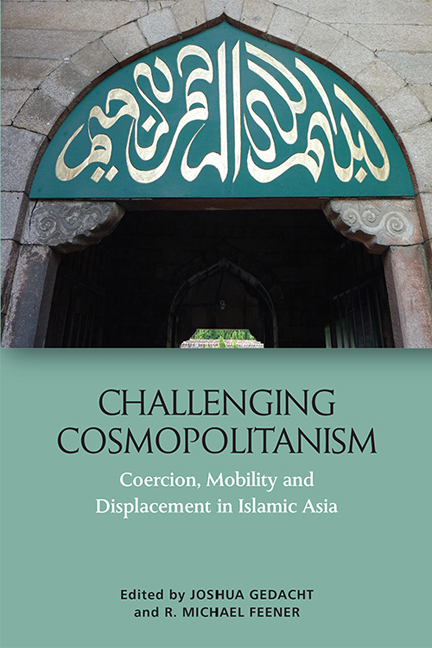Book contents
- Frontmatter
- Contents
- Preface
- 1 Hijra, Ḥajj and Muslim Mobilities: Considering Coercion and Asymmetrical Power Dynamics in Histories of Islamic Cosmopolitanism
- 2 Islamicate Cosmopolitanism from North Africa to Southeast Asia
- 3 Sufi Cosmopolitanism in the Seventeenth-century Indian Ocean: Sharīʿa, Lineage and Royal Power in Southeast Asia and the Maldives
- 4 The White Heron Called by the Muezzin: Shrines, Sufis and Warlords in Early Modern Java
- 5 Variations of ‘Islamic Military Cosmopolitanism’: The Survival Strategies of Hui Muslims during the Modern Period
- 6 Writing Cosmopolitan History in Nineteenth-century China: Li Huanyi’s Words and Deeds of Islamic Exemplars
- 7 The ‘Shaykh al-Islām of the Philippines’ and Coercive Cosmopolitanism in an Age of Global Empire
- 8 Bordering Malaya’s ‘Benighted Lands’: Frontiers of Race and Colonialism on the Malay Peninsula, 1887–1902
- 9 Afghanistan’s Cosmopolitan Trading Networks: A View From Yiwu, China
- Notes on the Contributors
- Index
6 - Writing Cosmopolitan History in Nineteenth-century China: Li Huanyi’s Words and Deeds of Islamic Exemplars
Published online by Cambridge University Press: 01 May 2021
- Frontmatter
- Contents
- Preface
- 1 Hijra, Ḥajj and Muslim Mobilities: Considering Coercion and Asymmetrical Power Dynamics in Histories of Islamic Cosmopolitanism
- 2 Islamicate Cosmopolitanism from North Africa to Southeast Asia
- 3 Sufi Cosmopolitanism in the Seventeenth-century Indian Ocean: Sharīʿa, Lineage and Royal Power in Southeast Asia and the Maldives
- 4 The White Heron Called by the Muezzin: Shrines, Sufis and Warlords in Early Modern Java
- 5 Variations of ‘Islamic Military Cosmopolitanism’: The Survival Strategies of Hui Muslims during the Modern Period
- 6 Writing Cosmopolitan History in Nineteenth-century China: Li Huanyi’s Words and Deeds of Islamic Exemplars
- 7 The ‘Shaykh al-Islām of the Philippines’ and Coercive Cosmopolitanism in an Age of Global Empire
- 8 Bordering Malaya’s ‘Benighted Lands’: Frontiers of Race and Colonialism on the Malay Peninsula, 1887–1902
- 9 Afghanistan’s Cosmopolitan Trading Networks: A View From Yiwu, China
- Notes on the Contributors
- Index
Summary
In 1874, the Chinese author Li Huanyi published a biographical compendium titled Words and Deeds of Islamic Exemplars (Qingzhen xianzheng yanxing lüe). In this collection, Li argued that Hui Muslims like himself had always been loyal supporters of the Chinese state, showing how this tradition was inaugurated during Muhammad's lifetime by the Prophet's Companion Saʿd b. Abī Waqqāṣ. Waqqāṣ connects the figures in Li's compendium with a larger world history featuring China and Arabia and stretching back to the origins of humanity with Adam. For Li, the Hui are not an ethnic or religious minority on the fringes of the Chinese and Islamic empires. Rather, they are central to both histories and to the history of humankind as a whole.
Li's cosmopolitanism lies in his ability to situate the Hui in relation to both Chinese and Islamic history. He proposes a simultaneous, interactive past between China and Arabia. Indeed, his text supports Edward Simpson and Kai Kresse's claim that history writing can participate in achieving a cosmopolitan ideal through its ‘conglomeration of pasts held in common’. Yet what is interesting about Li's collection is that even as the author establishes historical connections between China and Arabia, his overall message is to emphasise the long-standing devotion of the Hui to the Chinese state. In other words, rather than transgressing ethnic and national confines as Simpson and Kresse's definition of cosmopolitanism would suggest, Li depicts a shared history only to reach a definitive end-point in China. In this respect, the kind of universal history found within this biographical compendium invites us to consider how cosmopolitan worldviews are used in the service of particular political and patriotic agendas.
This chapter introduces Li's text and explores the temporal framework in Words and Deeds. I examine the author's use of the word Hui and the polemical investment behind it. Li situates the Hui in a larger world history featuring China and Arabia and dating back to the first human being, Adam. This is followed by a discussion of the figure of Saʿd b. Abī Waqqāṣ. I show how Li's text emerges from a background of traditions affirming the dual authorities of the Chinese emperor and Muḥammad in establishing the first Muslim presence in China. The figure of Saʿd b. Abī Waqqāṣ appears in these origin tales as mediator between two sovereigns.
- Type
- Chapter
- Information
- Challenging CosmopolitanismCoercion, Mobility and Displacement in Islamic Asia, pp. 145 - 171Publisher: Edinburgh University PressPrint publication year: 2018

